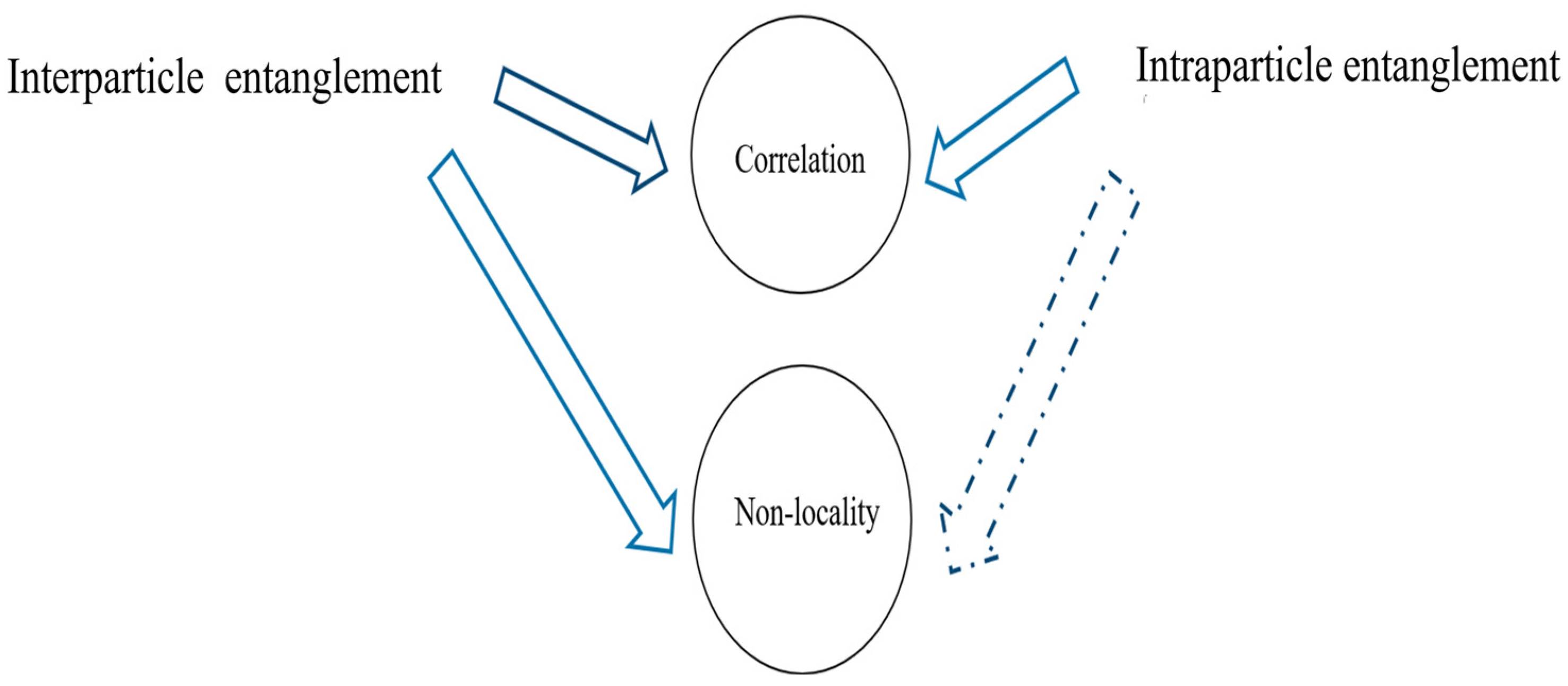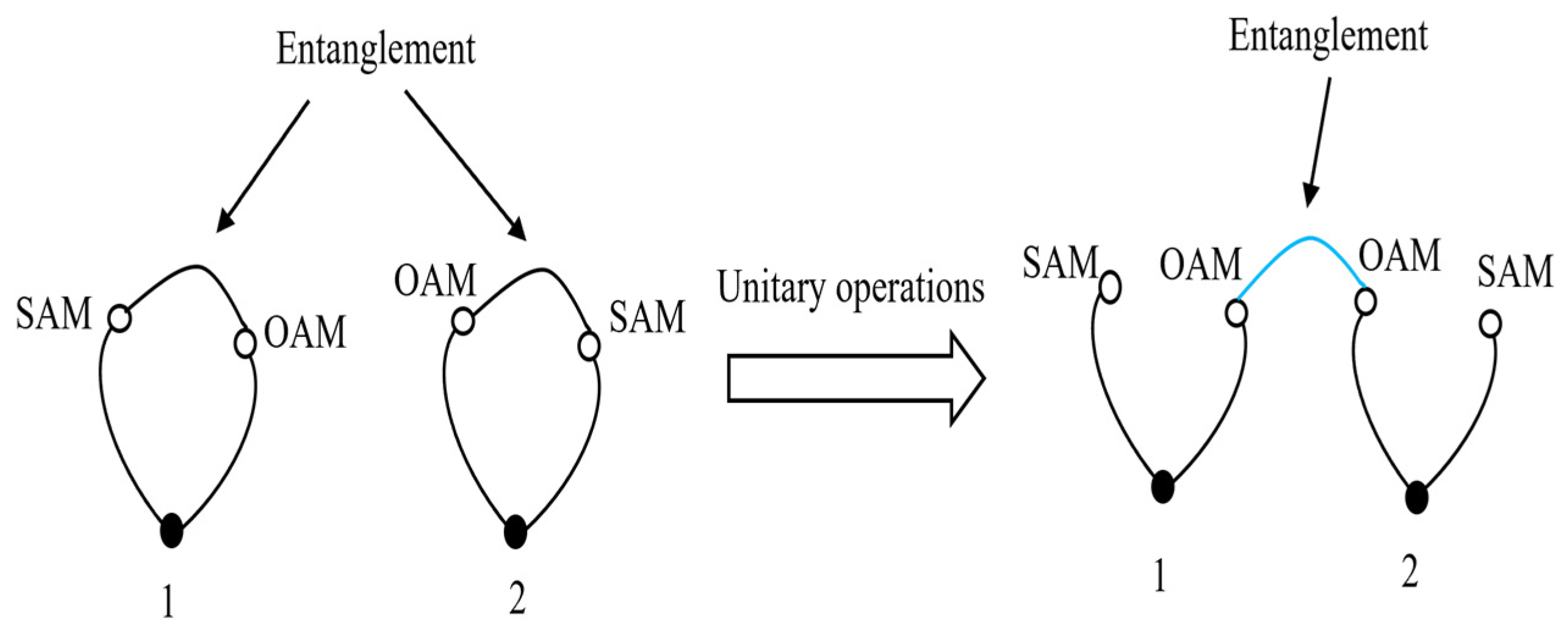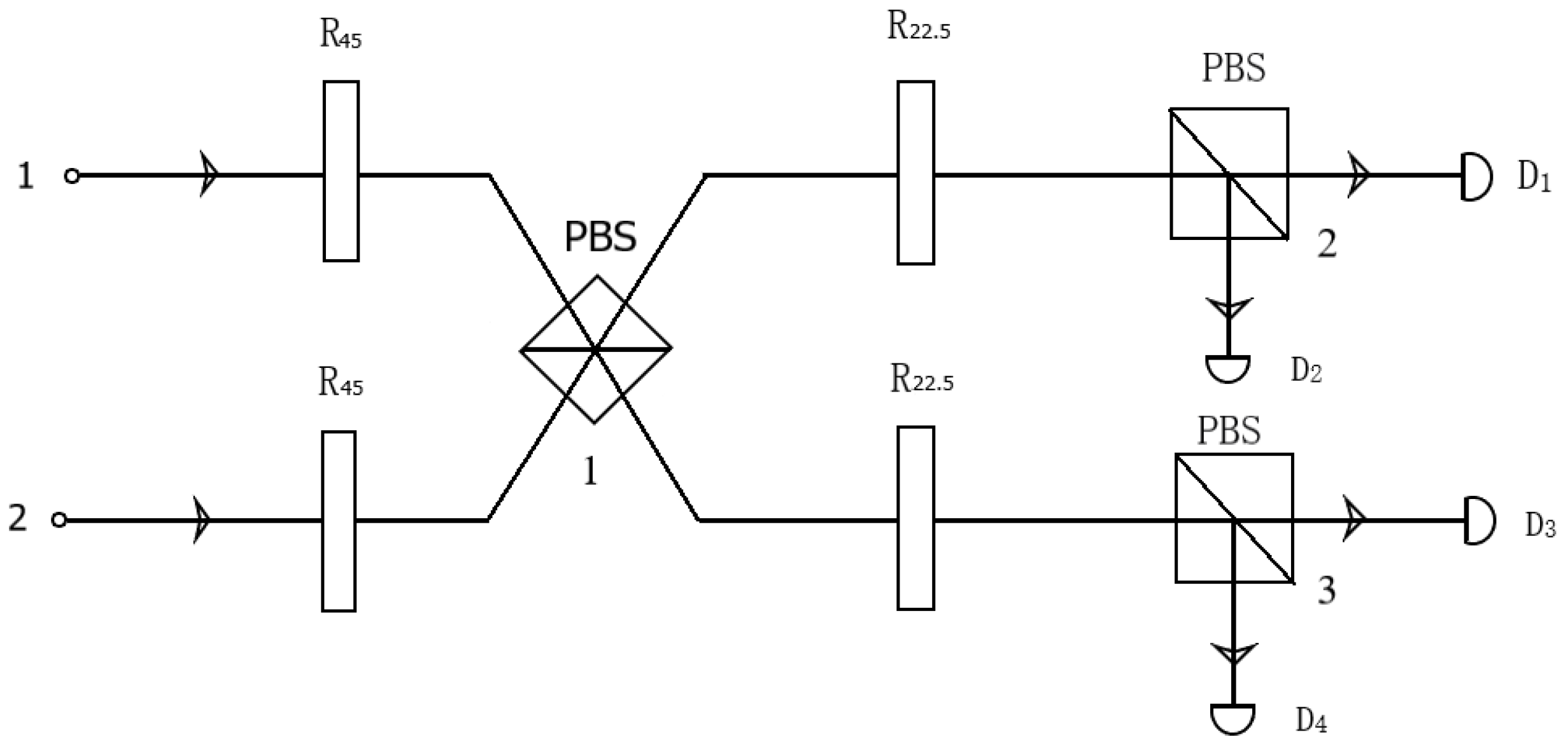Research on Intraparticle to Interparticle Entanglement Swapping Protocols
Abstract
:1. Introduction
2. The Distinctions and Similarities between the Two Kinds of Entangled States
2.1. Correlation and Non-Locality
2.2. Robustness
2.3. Generation and Separation Methods
2.4. Practical Application
3. Methods
3.1. Entanglement Swapping Protocols
3.1.1. Entanglement Swapping Principle
3.1.2. Entanglement Swapping Protocols Based on Bell State Joint Measurement
3.1.3. Entanglement Swapping Protocols Based on the Cross-Kerr Medium
3.1.4. Entanglement Swapping Protocols Based on Linear Optical Elements
4. Conclusions
Author Contributions
Funding
Institutional Review Board Statement
Informed Consent Statement
Data Availability Statement
Acknowledgments
Conflicts of Interest
References
- Pirandola, S.; Eisert, J.; Weedbrook, C.; Furusawa, A.; Braunstein, S.L. Advances in quantum teleportation. Nat. Photonics 2015, 9, 641–652. [Google Scholar] [CrossRef]
- Ekert, A.K. Quantum cryptography based on bell’s theorem. Phys. Rev. Lett. 1991, 67, 661. [Google Scholar] [CrossRef] [PubMed]
- Pironio, S. The certainty of randomness. Nature 2018, 556, 176. [Google Scholar] [CrossRef]
- Ashhab, S.; Maruyama, K.; Brukner, C.; Nori, F. Bell’s experiment with intra-and inter-pair entanglement: Single-particle mode entanglement as a case study. Phys. Rev. A 2009, 80, 062106. [Google Scholar] [CrossRef]
- Ebrahim, K.; Leach, J.; Slussarenko, S.; Piccirillo, B.; Marrucci, L.; Chen, L.X.; She, W.L.; Franke-Arnold, S.; Padgett, M.J.; Santamato, E. Spin-orbit hybrid entanglement of photons and quantum contextuality. Phys. Rev. A At. Mol. Opt. Phys. 2010, 82, 022115. [Google Scholar]
- Karsten, K.; Loock, P.V. Classifying, quantifying, and witnessing qudit-qumode hybrid entanglement. Phys. Rev. A At. Mol. Opt. Phys. 2012, 85, 032307. [Google Scholar]
- Waks, E.; Monroe, C. Protocol for hybrid entanglement between a trapped atom and a quantum dot. Phys. Rev. A: At. Mol. Opt. Phys. 2009, 80, 062330. [Google Scholar] [CrossRef]
- Knight, P. Quantum mechanics: Where the weirdness comes from. Nature 1998, 395, 12. [Google Scholar] [CrossRef]
- Gadway, B.R.; Galvez, E.J.; Zela, F.D. Bell-inequality violations with single photons entangled in momentum and polarization. J. Phys. B At. Mol. Opt. Phys. 2009, 42, 15503. [Google Scholar] [CrossRef]
- Kubatkin, S.; Danilov, A.; Hjort, M.; Cornil, J.; Bredas, J.L. Single-electron transistor of a single organic molecule with access to several redox states. Nature 2003, 425, 45. [Google Scholar] [CrossRef]
- Geppert, H.; Denkmayr, T.; Sponar, S.; Lemmel, H.; Hasegawa, Y. Improvement of the polarized neutron interferometer set-up demonstrating violation of a bell-like inequality. Nucl. Instrum. Meth. A 2014, 763, 417. [Google Scholar] [CrossRef] [PubMed]
- Shen, J.; Kuhn, S.J.; Dalgliesh, R.M. Quantum entangled-probe scattering theory. Nat. Commun. 2020, 11, 930. [Google Scholar] [CrossRef]
- Tang, J.M.; Zeng, Q.S.; Luo, Y.B.; Ye, Q.Y. The relationship between single-particle commuting observables Lz, Sz entangled states and the spin-orbit coupling. Quantum Inf. Process. 2020, 19, 1. [Google Scholar] [CrossRef]
- Vallés, A.; D’Ambrosio, V.; Hendrych, M.; Miuda, M.; Marrucci, L.; Sciarrino, F.; Torres, J.P. Generation of tunable entangle-ment and violation of a Bell’s like inequality between different degrees of freedom of a single photon. Phys. Rev. A 2014, 90, 052326. [Google Scholar] [CrossRef]
- Tang, J.M.; Zeng, Q.S.; Feng, N.X.; Wang, Z.F. Superdense Coding Based on Intraparticle Entanglement States. Eur. Phys. J. D 2022, 76, 172. [Google Scholar] [CrossRef]
- Chen, L.X.; She, W.L. Sorting photons of different rotational doppler shifts (RDS) by orbital angular momentum of single-photon with spin-orbit-RDS entanglement. Opt. Express 2008, 16, 14629. [Google Scholar] [CrossRef]
- Heo, J.; Hong, C.; Lim, J.; Yang, H. Bidirectional quantum teleportation of unknown photons using path-polarization intra-particle hybrid entanglement and controlled-unitary gates via cross-Kerr nonlinearity. Int. J. Theor. Phys. 2015, 54, 2481. [Google Scholar] [CrossRef]
- Heo, J.; Hong, C.H.; Lim, J.I.; Yang, H.J. Simultaneous quantum transmission and teleportation of unknown photons using intra-and inter-particle entanglement controlled-NOT gates via cross-Kerr nonlinearity and P-homodyne measurements. Int. J. Theor. Phys. 2015, 54, 2261. [Google Scholar] [CrossRef]
- Pramanik, T.; Adhikari, S.; Majumdar, A.S.; Home, D.; Pan, A.K. Information transfer using a single particle path-spin hybrid entangled state. Phys. Rev. A 2010, 374, 1121. [Google Scholar] [CrossRef]
- Briegel, H.J.; Dür, W.; Cirac, J.; Zoller, P. Quantum repeaters: The role of imperfect local operations in quantum communication. Phys. Rev. Lett. 1998, 81, 5932–5935. [Google Scholar] [CrossRef]
- Pan, J.W.; Dik, B.; Harald, W.; Anton, Z. Experimental entanglement swapping: Entangling photons that never interacted. Phys. Rev. Lett. 1998, 18, 3891. [Google Scholar] [CrossRef]
- Sciarrino, F.; Lombardi, E.; Milani, G.; Martini, F. Delayed-choice entanglement swapping with vacuum—One-photon quantum states. Phys. Rev. A 2002, 66, 024309. [Google Scholar] [CrossRef]
- Liu, S.S.; Lou, Y.B.; Chen, Y.X. All-optical entanglement swapping. Phys. Rev. Lett. 2022, 6, 060503. [Google Scholar] [CrossRef] [PubMed]
- Zang, S.M.; Shukla, C.; Rahman, A.; Zheng, B. Entanglement swapping and swapped entanglement. Entropy 2023, 25, 415. [Google Scholar] [CrossRef] [PubMed]
- Adhikari, S.; Majumdar, A.S.; Home, D.; Pan, A.K. Swapping path-spin intraparticle entanglement onto spin-spin interparticle entanglement. Europhys. Lett. 2010, 89, 10005. [Google Scholar] [CrossRef]
- Das, S.; Paul, G.; Banerji, A. Hyper-hybrid entanglement, indistinguishability, and two-particle entanglement swapping. Phys. Rev. A 2021, 102, 052401. [Google Scholar] [CrossRef]
- Kumari, A.; Ghosh, A.; Bera, M.L.; Pan, A.K. Swapping intraphoton entanglement to interphoton entanglement using linear optical devices. Phys. Rev. A 2019, 99, 032118. [Google Scholar] [CrossRef]
- Bayal, I.; Panchadhyayee, P. A protocol for conversion of path-spin to spin-spin quantum entanglement. J. Quantum Comput. 2023, 5, 71. [Google Scholar] [CrossRef]
- Yang, W.D.; Qiu, X.D.; Chen, L.X. Research Progress in Detection, Imaging, Sensing, and Micromanipulation Application of Orbital Angular Momentum of Beams. Chin. J. Lasers 2020, 47, 216. [Google Scholar]
- Konstantin, Y.B.; Elena, A.O.; Miguel, A.A.; Oscar, G.; David, L. Spin-to-orbital angular momentum conversion in focusing, scattering, and imaging systems. Opt. Express 2011, 19, 26132–26149. [Google Scholar]
- Aspect, A. Bell’s inequality test: More ideal than ever. Nature 1999, 398, 189–190. [Google Scholar] [CrossRef]
- Pittman, T.B.; Franson, J.D. Violation of Bell’s Inequality with Photons from Independent Source. Phys. Rev. Lett. 2003, 90, 240401. [Google Scholar] [CrossRef] [PubMed]
- Michler, M.; Weinfurter, H.; Zukowski, M. Experiments towards falsification of noncontextual hidden variable theories. Phys. Rev. Lett. 2000, 84, 5457. [Google Scholar] [CrossRef] [PubMed]
- Tang, J.M.; Zeng, Q.S.; Wu, Y.; Fan, D.G. Low-decoherence quantum information transmittal scheme based on the single-particle various degrees of freedom entangled states. Quantum Inf. Process. 2020, 19, 389. [Google Scholar] [CrossRef]
- Saha, P.; Sarkar, D. Robustness measure of hybrid intra-particle entanglement, discord, and classical correlation with initial Werner state. Quantum Inf Process. 2016, 15, 791. [Google Scholar] [CrossRef]
- Kim, T.; Fiorentino, M.; Wong, F.N.C. Phase-stable source of polarization-entangled photons using a polarization Sagnac in-terferometer. Phys. Rev. A At. Mol. Opt. Phys. 2006, 73, 012316. [Google Scholar] [CrossRef]
- Bai, J.; Guo, Q.; Cheng, L.Y. Implementation of nonlocal Bell-state measurement and quantum information transfer with weak Kerr nonlinearity. Chin. Phys. B 2011, 20, 120307. [Google Scholar] [CrossRef]
- Azzini, S.; Mazzucchi, S.; Moretti, V.; Pastorello, D.; Pavesi, L. Single-Particle entanglement. Adv. Quantum Technol. 2020, 3, 064306. [Google Scholar] [CrossRef]
- Imoto, N.; Haus, H.A.; Yamamoto, Y. Quantum nondemolition measurement of the photon number via the optical kerr effect. Phys. Rev. A 1985, 32, 2287–2292. [Google Scholar] [CrossRef]





| Measurement Results | Corresponding Unitary Operators |
|---|---|
Disclaimer/Publisher’s Note: The statements, opinions and data contained in all publications are solely those of the individual author(s) and contributor(s) and not of MDPI and/or the editor(s). MDPI and/or the editor(s) disclaim responsibility for any injury to people or property resulting from any ideas, methods, instructions or products referred to in the content. |
© 2024 by the authors. Licensee MDPI, Basel, Switzerland. This article is an open access article distributed under the terms and conditions of the Creative Commons Attribution (CC BY) license (https://creativecommons.org/licenses/by/4.0/).
Share and Cite
Tang, J.; Wang, S.; Liang, B.; Gong, Y. Research on Intraparticle to Interparticle Entanglement Swapping Protocols. Appl. Sci. 2024, 14, 8035. https://doi.org/10.3390/app14178035
Tang J, Wang S, Liang B, Gong Y. Research on Intraparticle to Interparticle Entanglement Swapping Protocols. Applied Sciences. 2024; 14(17):8035. https://doi.org/10.3390/app14178035
Chicago/Turabian StyleTang, Jiangmei, Shaomeng Wang, Bingyang Liang, and Yubin Gong. 2024. "Research on Intraparticle to Interparticle Entanglement Swapping Protocols" Applied Sciences 14, no. 17: 8035. https://doi.org/10.3390/app14178035





